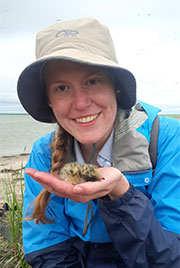#HowToNature series: How to butterfly
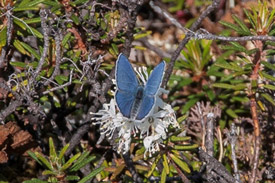
Cranberry blue. (Photo by Claire Elliott/NCC intern)
Though August may be drawing to a close, butterfly season is not over yet. Many of Canada’s 200 plus species of butterflies remain active well into the fall. Below are some tips to take with you into the field next time you go out searching for butterflies.
What to bring:
Camera: Really, any camera will do the trick. I’ve taken butterfly photos with everything from my cell phone camera to a Nikon D7100. A zoom lens is useful for taking photos of elusive butterflies that won’t let you get close. On the other hand, if you are able to get close to a butterfly, a macro lens allows for those tight, crisp shots. When photographing butterflies, patience combined with a good stalking technique (slow and steady) increases your chance of getting good shots.
Binoculars: Sometimes the naked eye is just not powerful enough to see a feature like a distinguishing field identification mark. A good pair of close-focussing binoculars is a handy tool for seeing small details in the field.
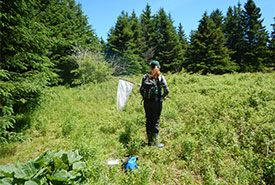
Claire trying to catch a butterfly with her net. (Photo by Mitchell MacMillan/ NCC PEI conservation planner)
Net: A butterfly net is great for getting up close and personal with butterflies. Using a net does not necessarily cause harm to the butterfly if they are handled gently. Place caught butterflies in a clear jar for a good view. When you’re done, release the butterfly back to the wild. Using a net is excellent way to get children interested and actively involved in watching butterflies.
Field guide: A field guide is helpful not only for identification, but it can also provide information on the flight season and distribution of individual species. There are provincial field guides available, such as the Royal Ontario Museum Field Guide to Butterflies of Ontario, as well as regional, national and continental field guides, such as Peterson Field Guides, The Butterflies of Canada and Butterflies and Moths of North America.
Where and when to go:
Different species of butterflies use a range of habitats, so I can almost guarantee there are butterflies somewhere near you. If you would like to view a variety of butterflies, there are four key factors you need to take into consideration:
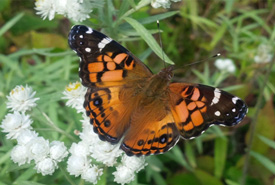
American lady. (Photo by Claire Elliott/NCC intern)
- habitat
- abundance
- distribution
- flight season
Some butterflies prefer meadows while others may require forest or tundra habitats. Knowing what habitats are near you will help narrow down which butterflies you will be able to see. Knowing distribution will tell you which butterfly species are limited to specific regions of Canada versus those that can be found coast to coast. Abundance describes how common a specific species may be. Lastly, flight season tells you when a butterfly species is flying. Some species have only short flight seasons each year, while others may have long flight seasons or even multiple distinct flight seasons. If you are interested in learning more about where and when to go looking for butterflies, the best place to start is with a local field guide.
Your own backyard: Another fantastic way to view butterflies is to attract them to your own backyard with a butterfly garden. In the creation of your butterfly garden you need to think about a few key points: providing food plants for caterpillars, providing food plants for adults, and providing shelter and sunlight. There are many great native flowers that can be cultivated in a butterfly garden. To find the best plants native to your region, talk to a local plant nursery or consult an organization such as the North American Native Plant Society.
Resources:
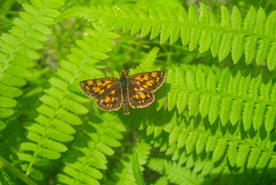
Arctic skipper. (Photo by Claire Elliott/ NCC intern)
In addition to the above information, there are some very helpful online resources freely available that will help with your butterfly watching endeavours.
eButterfly: eButterfly is a fantastic online resource and citizen science project. Through the website you can maintain your butterfly observation records and photos, as well as access information on butterfly observations from across the world.
Butterfly Atlases: Many provinces are engaging in their own butterfly surveys to create atlases that provide distribution and abundance data on provincial species. These projects are also the product of butterfly enthusiasts volunteering their time to collect data in their locality. Current atlases include the Maritimes Butterfly Atlas, Ontario Butterfly Atlas, and the British Columbia Butterfly Atlas.
Reference
Hall, Peter W., Colin D. Jones, Antonia Guidotti, and Brad Hubley. The ROM Field Guide to Butterflies of Ontario. Toronto, Ontario: Royal Ontario Museum, 2014. Print.

